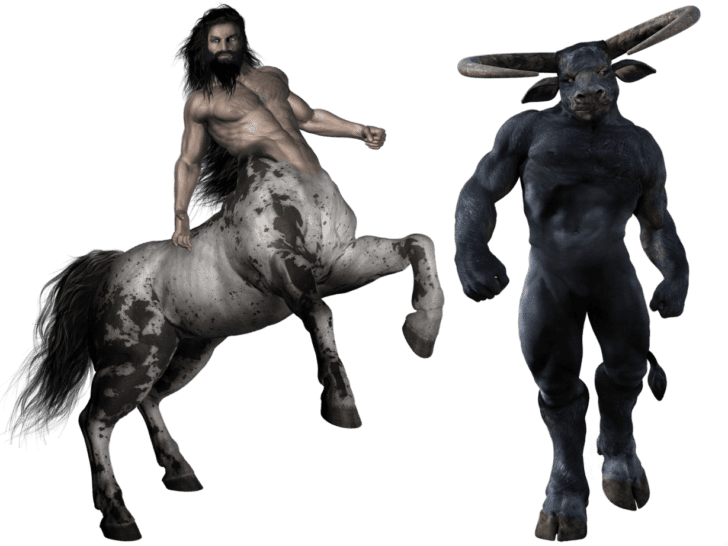Centaurs and minotaurs are popular mythological figures and have been the subject of various stories, legends, and artworks throughout history. The two half-human creatures have different origins and appearances, with centaurs portrayed as human from the waist up and horses from the waist down while minotaurs have the head and torso of a human and the body of a bull. In mythology, centaurs are known for strength, speed, and agility, while minotaurs possess immense physical strength and great cunning and intelligence. Both creatures represent different aspects of the human experience, and they have had a significant impact on Western culture as a source of inspiration for various art forms.
Centaurs vs. Minotaurs: A Comparison of Half-Human Creatures in Mythology
When it comes to half-human creatures in mythology, centaurs and minotaurs are among the most famous and intriguing. Both have been the subject of countless stories, legends, and artworks throughout the centuries. But what are the main differences and similarities between these two mythological beings? Let’s take a closer look.
Origins and Appearance
Centaurs and minotaurs have different origins in mythology. Centaurs are typically portrayed as the offspring of Ixion, a mortal king, and the cloud nymph Nephele. In contrast, minotaurs are said to be the children of King Minos of Crete and a supernatural bull sent by Poseidon, the god of the sea.
Centaurs are usually depicted as creatures with the upper body of a human and the lower body of a horse. They are known for their wild and savage nature, as well as their love of wine, women, and song. Minotaurs, on the other hand, have the head and torso of a human and the body of a bull. They are often portrayed as fierce and dangerous creatures, with a tendency to devour humans who cross their path.
Character Traits and Abilities
In mythology, centaurs and minotaurs are often associated with different traits and abilities. Centaurs are known for their strength, speed, and agility, as well as their exceptional skill with the bow and arrow. They are often depicted as skilled hunters and warriors, but also as impulsive and unpredictable beings who can fly into a rage at the slightest provocation.
Minotaurs, on the other hand, are usually portrayed as creatures with immense physical strength and a fierce determination to destroy their opponents. They are often depicted as possessing great cunning and intelligence, as well as the ability to navigate labyrinths and other complex structures with ease. However, they are also seen as brutish and bestial beings who lack empathy and compassion.
Mythological Significance
Centaurs and minotaurs play important roles in mythology, representing different aspects of the human experience. Centaurs symbolize the struggle between reason and passion, civilization and savagery, as well as the duality of man’s nature. They are often used as metaphors for the conflict between the rational Apollonian and the passionate Dionysian forces that shape our lives.
Minotaurs, on the other hand, represent the darker aspects of the human psyche, such as rage, violence, and the urge to dominate and control others. They are often seen as monsters that need to be defeated, as a way of exorcising our own demons and overcoming our fears and insecurities.
Cultural Significance
Both centaurs and minotaurs have had a significant impact on Western culture, inspiring countless works of art, literature, and popular culture. From ancient Greek pottery to modern-day movies and video games, these half-human beings have captured the imagination of people throughout the ages.
Centaurs have been depicted in a variety of different ways, from the noble and wise Chiron, who mentored heroes like Achilles and Jason, to the violent and crude centaurs of Greek mythology, who were known for their drunken orgies and savage behavior. In modern popular culture, centaurs have also been portrayed in a more lighthearted and whimsical manner, such as the character of Firenze in the Harry Potter series.
Minotaurs, on the other hand, have been depicted as terrifying monsters that embody the primal aspects of our nature. From the mythological labyrinth of King Minos to the more recent depiction of the Minotaur in the Percy Jackson series, these creatures have been a source of fear and fascination for generations.
Conclusion
In conclusion, centaurs and minotaurs are two of the most fascinating and iconic half-human creatures in mythology. While they share certain traits and characteristics, such as their strength and animalistic nature, they also have significant differences in terms of their appearance, abilities, and mythological significance. Whether we see them as symbols of our own inner conflicts or as terrifying monsters to face and overcome, these half-human beings continue to capture our imaginations and inspire us to explore the mysteries of the human psyche.
